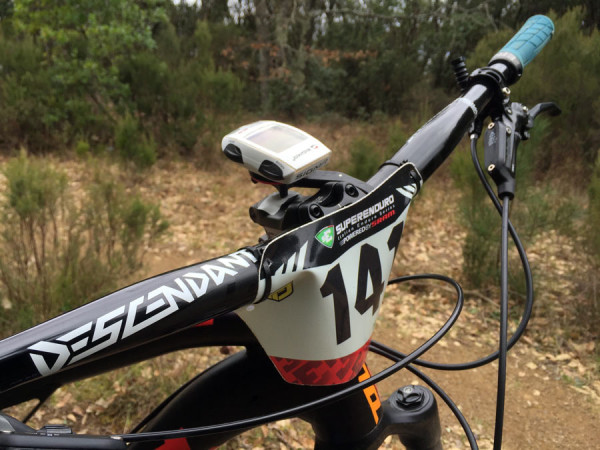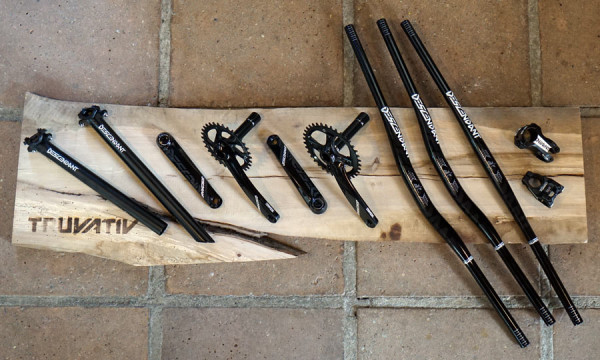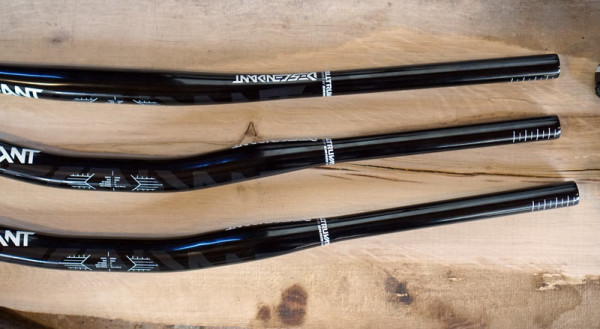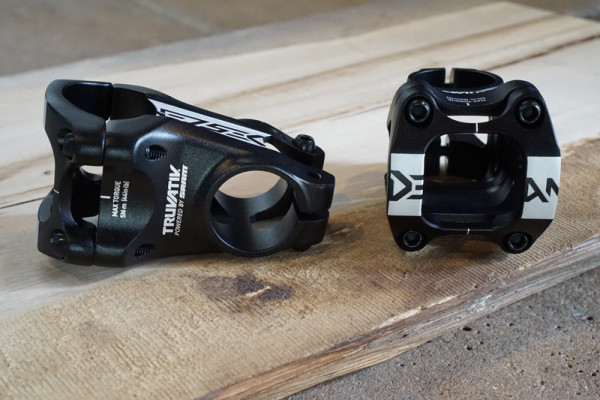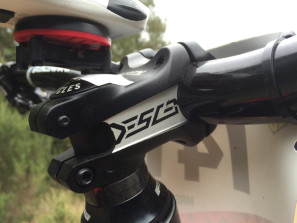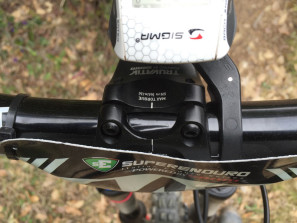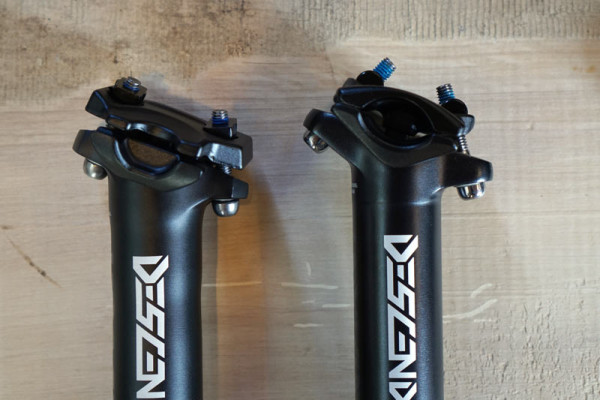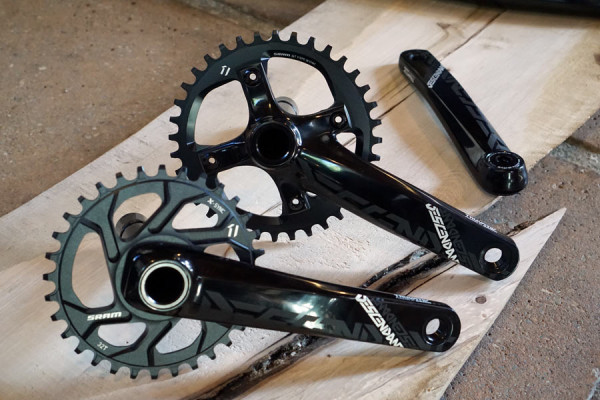The new Truvativ Descendant cranks are an evolution of the very first Truvativ cranks from that brand’s origin. Think back (or Google it if you’re that young) and you may recall that Truvativ shook up the mountain bike world when they introduced their Stylo cranks and external cup bottom bracket and Isis crank-to-spindle interface. Early versions may not have held up that well, but there’s little argument they ushered in a now common BB-and-spindle interface.
Since then, various models of Truvativ cranks have filled SRAM’s gravity lineup. Now, Descendant is making Holzfeller and AKA obsolete, giving riders a more versatile, refined family of products to cover everything from aggressive all mountain to full blown downhill. And the Holzfeller stem was sort of chunky, the Descendant replacement machines away unnecessary material.
Now, the entire line has a far more refined look, adds carbon and alloy handlebars and gets both direct mount and four-arm cranks, plus a carbon crankset, each with its own intended user. Even the seatposts get a little more aggressive…
The handlebars take a lot of what they’ve learned from previous models, using the Boobar’s shape, sweep and width, with variances in the tube’s thickness and butting. It’s made to take all kinds of abuse, while still allowing a tiny bit of flex so they’re not too rigid.
The DH bar comes in at 800mm wide with 5º upsweep and 9º backsweep. The AM/EN bar is 760mm wide with 5º upsweep and 7º backsweep. Both are made of 7050 alloy and stick with a 31.8mm diameter rather than jumping up to the stiffer 35mm. They say the 7050 alloy provides the right mix of fatigue life and yield strength. The latter is a material’s ability to deform and return it’s original shape without breaking. The bar diameter was intentional to maintain a balance between stiffness and compliance, saying that anything stiffer would send too much force to the rider and exacerbate arm pump and fatigue.
Specs checklist for each:
- Carbon Flat Bar – $150 (€163/£126) / 7º backsweep / 750mm wide
- Carbon Riser Bar – $150 (€163/£126) / 7º backsweep / 5º upsweep / 20mm rise/ 750mm wide
- Alloy Flat Bar – $65 (€71/£54) / 7º backsweep / 760mm wide
- Alloy Riser Bar – $65 (€71/£54) / 7º backsweep / 5º upsweep / 20mm rise/ 760mm wide
- Alloy DH Bar – $70 (€77/£59) / 9º backsweep / 5º upsweep / 25mm rise/ 800mm wide
The new stem is 3D forged of 7050 alloy and comes in 40/50/60 millimeter lengths, all with 0º rise. Only offered in 31.8 clamp diameter, like the bars. They get steel bolts, four up front and two clamping to the steerer tube. Claimed weights are 149g to 168g. Pricing is $65 (€71 / £54)
These are the same products they’re putting on their sponsored riders’ bikes, which means they’re headed to everything from World Cup DH races to the Red Bull Rampage. Why? Because they know good and well all of us are riding products beyond what their intended uses are, so they’re over built to handle anything you’re going to throw at them.
Seatposts are offered in standard and DH versions, with the latter getting a different saddle angle adjustment range. With DH riders often running the saddle’s nose pointing up, SRAM found many riders end up at the limit of a post’s adjustable range even when spinning it around backward, so this one extends the angles.
It’s also 3D forged of 7050 alloy with internal relieving at the bottom and external shaping at the top to make it strong where needed without being a brick. They have 0mm offset, come in 30.9 and 31.6 diameters, 350-400mm lengths, and have a claimed weight of 235-275g. Retail is $50 (€54 / £42). Granted, most riders are running dropper posts unless these are going on a full DH rig, which is why they also just revamped their Reverb with impressive new internals.
The hollow forged Holzfeller crank arms were nice, but they were also very stiff. This not only transmitted more force to the rider, but it actually decreased fatigue life compared to a non-hollow forged design. The new Descendant cranks use a standard 7000-series forged design with a relieved backside that provides an application-appropriate amount of give but still tough enough for downhill racing. They’re also less expensive.
DH cranks use a four-bolt chainring, which provides a higher total strength for the system than the direct mount, so they’ll only offer the longer DH-specific spindle length on the four-bolt design. The direct mount cranks will fit any of SRAM’s direct mount chainrings and is more for all-mountain riding.
The direct mount cranks come in at $161-188 (€175-205 / £134-158), are available in BB/PF30 and GXP versions (68/73mm spindles), have 170 and 175 mm length options, come with a 32-tooth chainring and weigh in at a claimed 674g (GXP, 175mmm w/ ring). Boost offset chainrings can be used, too.
The DH four-arm cranks get the longer 83mm BB/PF30 and GXP spindles or 104.5/107mm PF GXP spindle for a 55mm chainline, will retail for $151-196 (€166-214 / £122-158), come in 165 and 170mm lengths and have a claimed weight of 725g (GXP, 165mm, 34-tooth ring included). BCD is 94mm.
A carbon version is also in the works, but wasn’t available for photos. This one brings the otherwise gravity-oriented group all the way up to XC weights but built to handle aggressive all mountain riding. It’s available in a 170mm and 175mm lengths, but otherwise options are same as alloy direct mount cranks. Claimed weight is 587g w/ 32-tooth direct mount chainring. Retail pricing will be $311-340 (€340-371 / £262-286).
All products will be available in June 2016.
